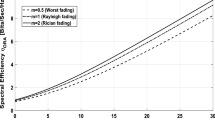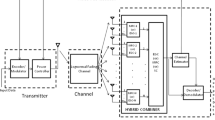Abstract
In this paper, closed-form expressions for the capacities per unit bandwidth (spectrum efficiency) of Weibull fading channels are derived and plotted for (a) Switch and Stay Combining diversity case and (b) no diversity case for adaptation policies like: (i) Optimal Power and Rate Adaptation policy, (ii) Optimal Rate Adaptation with constant transmit power policy, (iii) Channel Inversion with Fixed Rate policy, and (iv) Truncated Channel Inversion policy. In addition, spectrum efficiency expressions for asymptotic approximations, upper bounds, approximations for low and high SNR cases are derived for the cases with and without diversity. The probability density function of capacity, and the complementary cumulative distribution function of capacity are derived and plotted from the moment generating function for the cases with and without diversity. Optimal power and rate adaptation policy provides the highest capacity and optimal rate adaptation with constant transmit power policy provides the highest capacity penalty over other policies for the no diversity and SSC diversity cases. Numerical results for spectrum efficiency are plotted for all adaptation policies with and without diversity.
Similar content being viewed by others
References
Proakis J. (2001) Digital communications (4th ed.). McGraw Hill, New York
Sklar, B. (2001). Digital communications: Fundamentals and applications (2nd ed.). Pearson Education Asia.
Rappaport T. (2004) Wireless communications: Principles and practice (2nd ed.). Prentice Hall Inc., Englewood Cliffs
Sagias N., Zogas D., Karagiannidis G., Tombras G. (2004) Channel capacity and second-order statistics in Weibull fading. IEEE Communication Letters 8(6): 377–379
Hailin X., Zaiping N. (2006) Channel capacity and digital modulation schemes in correlated Weibull fading channels with non-identical statistics. International Conference on Communications, Circuits and Systems 2: 839–842
Alouini, M., & Goldsmith, A. (1997). Capacity of Nakagami multipath fading channels. In 47th IEEE International Vehicular Technology Conference (VTC ’97), pp. 358–362.
Goldsmith A., Varaiya P. (1997) Capacity of fading channels with channel side information. IEEE Transactions on Information Theory 43(6): 1986–1992
Alouini M., Goldsmith A. (2000) Comparison of fading channel capacity under different CSI assumptions. 52nd IEEE Vehicular Technology Conference 4: 1844–1849
Sagias N., Tombras G., Karagiannidis G. (2005) New results for the Shannon channel capacity in generalized fading channels. IEEE Communication Letters 9(2): 97–99
Bithas P., Mathiopoulos P. (2009) Capacity of correlated generalized gamma fading with dual branch selection diversity. IEEE Transactions on Vehicular Technology 58(9): 5258–5263
Bithas, P., Mathiopoulos, P., & Kotsopoulos, S. (Sep. 2008). On the capacity of generalized fading/shadowing channels. InIEEE 68th vehicular technology conference (pp. 1–5). Calgary, BC, Canada.
Abualhaol, I., & Matalgah, M. (June 2007) Capacity analysis of MIMO systems over identically independent distributed Weibull fading channels. In IEEE International Conference on Communications, pp. 5003–5008.
Sagias N., Zogas D., Karagiannidis G. (2005) Selection diversity receivers over nonidentical Weibull fading channels. IEEE Transactions on Vehicular Technology 54(6): 2146–2151
Bithas, P., Mathiopoulos, P., & Karagiannidis, G. (Sep. 2006). Switched diversity receivers over correlated Weibull fading channels. In International Workshop on Satellite and Space Communications, pp. 143–147.
Ismail, M., & Matalgah, M. (Nov. 2006). Performance analysis of dual selection switch and stay combining diversity receivers over Weibull fading with cochannel interference. In IEEE Global Telecommunications Conference, pp. 1–5.
Ismail M., Matalgah M. (2006) Performance of dual maximal ratio combining diversity in nonidentical correlated Weibull fading channels using Pade approximation. IEEE Transactions on Communications 54(3): 397–402
Sagias N., Mathiopoulos P. (2005) Switched diversity receivers over generalized gamma fading channels. IEEE Communication Letters 9(10): 871–873
Abu-Dayya A., Beaulieu N. (1994) Analysis of switched diversity systems on generalized fading channels. IEEE Transactions on Communications 42(11): 2959–2966
Sagias N. (2006) Capacity of dual branch selection diversity receivers in correlative Weibull fading. European Transactions on Telecommunications 17(1): 37–43
Alouini M., Goldsmith A. (1999) Capacity of Rayleigh fading channels under different adaptive transmission and diversity-combining techniques. IEEE Transactions on Vehicular Technology 48(4): 1165–1181
Bhaskar V. (2009) Error probability distribution and density functions for Weibull fading channels with and without diversity combining. International Journal of Wireless Information Networks 16(1–2): 91–97
Gradshteyn I., Ryzhik I. (1994) Table of integrals, series, and products (5th ed.). Academic Press, San Diego, CA
Abramowitz M., Stegun I. (1972) Handbook of mathematical funcions with formulae, graphs and mathematical tables (9th ed.). Dover, NewYork (NY), USA
Bhaskar V. (2009) Capacity evaluation for equal gain diversity schemes over Rayleigh fading channels. International Journal of Electronics and Communications 63(4): 235–240
Dohelr M., Aghvami H. (2005) On the approximation of MIMO capacity. IEEE Transactions on Wireless Communications 4(1): 30–34
Jakes W. (1994) Microwave mobile communications (2nd ed.). IEEE Press, Piscataway, NJ
Shannon C. (1948) A mathematical theory of communication. Bell Systems Technical Journal 27: 397–423
Author information
Authors and Affiliations
Corresponding author
Rights and permissions
About this article
Cite this article
Bhaskar, V., Banerjee, A. Spectrum Efficiency of Weibull Fading Channels for Various Adaptation Policies with and Without Diversity Combining. Wireless Pers Commun 65, 797–823 (2012). https://doi.org/10.1007/s11277-011-0311-x
Published:
Issue Date:
DOI: https://doi.org/10.1007/s11277-011-0311-x




